
Malvaceae, or the mallows, is a family of flowering plants estimated to contain 244 genera with 4225 known species. Well-known members of economic importance include okra, cotton, cacao and durian. There are also some genera containing familiar ornamentals, such as Alcea (hollyhock), Malva (mallow) and Lavatera, as well as Tilia. The largest genera in terms of number of species include Hibiscus, Sterculia, Dombeya, Pavonia and Sida.

Abutilon is a large genus of flowering plants in the mallow family, Malvaceae. It is distributed throughout the tropics and subtropics of the Americas, Africa, Asia, and Australia. General common names include Indian mallow and velvetleaf; ornamental varieties may be known as room maple, parlor maple, or flowering maple. The genus name is an 18th-century New Latin word that came from the Arabic ’abū-ṭīlūn, the name given by Avicenna to this or a similar genus.

Abutilon menziesii, known as Koʻoloaʻula in Hawaiian, is an endangered species of flowering shrub in the mallow family, Malvaceae, that is endemic to Hawaii. It is a sprawling shrub that can reach up to 10 feet in height. The leaves, which range from an inch in width to about five inches, vary in their shapes. They have a velvety feel to them. The small hibiscus-shaped flowers generally hang downward. Though charming up close, the flowers can be hidden by the much larger leaves and not often visible at a distance. Although the Hawaiian name ʻula refers to the more commonly seen red color, koʻoloa ʻula flowers are known in a range of colors: pink, pink and white, pale red, maroon, deep purplish-red (wine), salmon, and blond or butter. The center or staminal column is yellowish.

Abutilon pictum, syn. Abutilon striatum (disputed), is a species of flowering plant in the family Malvaceae. It is native to southern Brazil, Argentina, Paraguay and Uruguay. The plant has become naturalised in Central America, and is used in horticulture. Common names include redvein abutilon, red vein Indian mallow, redvein flowering maple, Chinese-lantern and red vein Chinese lanterns.
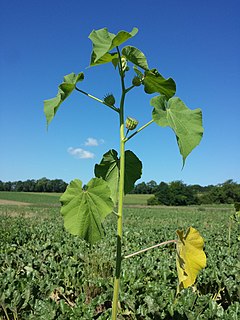
Abutilon theophrasti is an annual plant in the family Malvaceae, native to southern Asia. Its specific epithet theophrasti commemorates the ancient Greek botanist-philosopher Theophrastus. Abutilon theophrasti is the type species of the genus Abutilon.
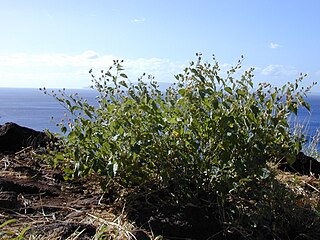
Abutilon icanum, also known as hoary abutilon, pelotazo, pelotazo chico, tronadora, and maʻo (Hawaiʻi), is a shrub widespread throughout the arid, warm regions of the southwestern United States and northern Mexico as well as Hawaiʻi.

Napaea is a monotypic genus of flowering plants in the mallow family Malvaceae. The single species is Napaea dioica, a tall perennial herbaceous plant, native to central and eastern USA. Plants are occasionally grown as ornamentals in wildflower gardens. A common name is glade mallow.
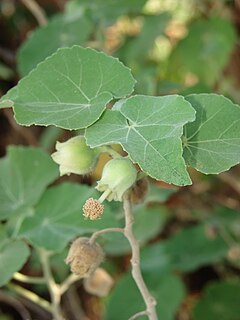
Abutilon eremitopetalum, commonly known as the hidden-petaled abutilon or hiddenpetal Indian mallow, is a species of flowering shrub in the mallow family, Malvaceae. It is endemic to dry forests and low shrublands on the windward side of the island of Lānaʻi in Hawaii. It is classified by the IUCN Red List as critically endangered by habitat destruction. The species was first discovered in 1987.
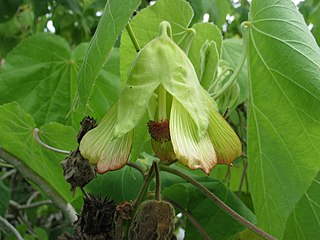
Abutilon sandwicense, commonly known as the greenflower Indian mallow, is a species of flowering plant in the mallow family, Malvaceae, that is endemic to the island of Oʻahu, Hawaii, in the United States. It inhabits dry forests on the slopes of the Waiʻanae Range at elevations of 400–600 m (1,300–2,000 ft). Associated plants include lama, ēlama, māmaki, kalia, āulu, olopua, and alaheʻe. Greenflower Indian mallow is a shrub, reaching a height of 1.5–3 m (4.9–9.8 ft). It is threatened by habitat loss.

Malva sylvestris is a species of the mallow genus Malva in the family of Malvaceae and is considered to be the type species for the genus. Known as common mallow to English-speaking Europeans, it acquired the common names of cheeses, high mallow and tall mallow as it migrated from its native home in Western Europe, North Africa and Asia through the English-speaking world.

Abutilon palmeri, known as Palmer's abutilon, superstition mallow, and Palmer's Indian mallow is a species of flowering plant native the Southwestern United States and northwestern Mexico.

Abutilon grandifolium, the hairy Indian mallow, is a large shrub that is up to 3 m (9.8 ft) high with broad, 3–18 cm (1.2–7.1 in) leaf blades. Flowers are axillary, with a yellow corolla 2–3.5 cm (0.8–1.4 in) across, composed of petals 1–1.5 cm (0.4–0.6 in) long. The fruits are ovoid-globular schizocarps that are 1–1.5 cm (0.4–0.6 in) in diameter and composed of ten shortly beaked mericarps, containing 2-3 seeds each.
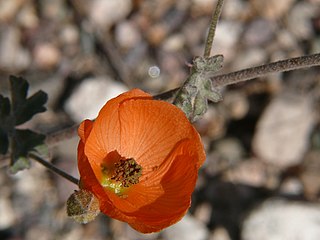
Sphaeralcea ambigua, is a species of flowering plant commonly known as desert globemallow or apricot mallow, is a member of the genus Sphaeralcea in the mallow family (Malvaceae).
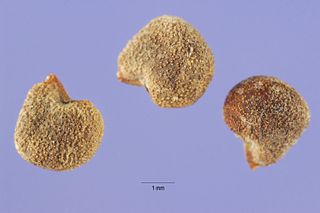
Anoda cristata is a species of flowering plant in the mallow family known by many common names, including spurred anoda, crested anoda, and violettas. It is native to North and South America. It is known throughout the rest of the Americas as well as Australia as an introduced species and often a noxious weed. It has been found as a weed in Belgium. Naturally, it is often found near streams, in moist meadows, and in disturbed areas.
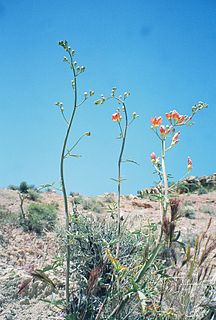
Sphaeralcea gierischii, Gierisch's globemallow or Gierisch mallow, is an endangered species of flowering plant in the mallow family, Malvaceae. It is native to the western United States, where it is known only from Utah and Arizona. It was described in 2002.

Malvella leprosa is a species of flowering plant in the mallow family known by the common names alkali mallow and alkali sida. It is native to much of the western United States, Mexico, Argentina, and Chile. It is known in parts of Australia as an introduced species. In many regions, whether native there or not, the plant is often a noxious weed and easily invades habitat, including areas with alkaline and saline soils. In California, the plant can be found in agricultural lands, including fields and orchards. This is a decumbent perennial herb producing a white-hairy stem up to about 40 centimetres (16 in) long, spreading along the ground. The leaves are variable in shape but are generally lobed and wavy along the edges, measuring 1 to 3 centimetres wide. Leaves appear in the leaf axils singly or in clusters of up to 3. Each flower is a cup-shaped corolla of five petals up to 1.5 centimetres long in shades of pale pink, white, or light yellow. The disc-shaped fruit is divided into several segments.

Sidalcea covillei is an uncommon species of flowering plant in the mallow family known by the common names Owens Valley sidalcea, and Owens Valley checkerbloom. It is endemic to the Owens Valley of Inyo County, California, where it grows on alkali flats and in alkaline meadows and springs. While it is limited to this single valley, it is known from 44 sites there, and several populations are relatively large, with the total global population estimated at about two million individuals.

Abutilon parishii is a species of flowering plant in the mallow family known by the common names Parish's Indian mallow and Pima Indian mallow. It is native to Arizona in the United States and Sonora in Mexico.

Abutilon fruticosum is a widespread species of flowering plant in the mallow family known by the common names Texas Indian mallow, pelotazo, and sweet Indian mallow. It is native to Africa, southern and southwestern Asia, northern Mexico, and the south-central United States.

Malva pusilla, also known as Malva rotundifolia, the low mallow, small mallow, or the round-leaved mallow, is an annual and biennial herb species of the Mallow genus Malva in the family of Malvaceae. Malva is a genus that consists of about 30 species of plants. This genus consists of plants named mallows. Mallows grow in many regions, including temperate, subtropical, and tropical areas.




















